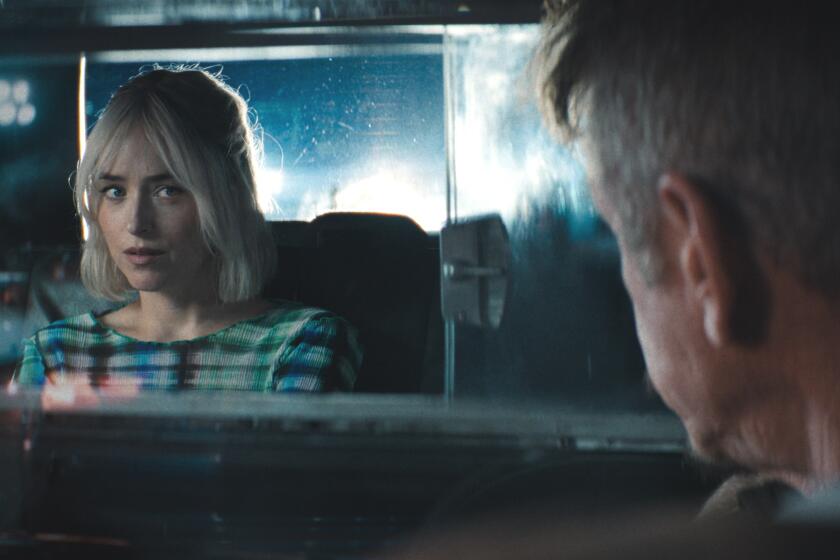Tripping the Light
“Etonne-moi”--astonish me--ballet impresario Sergei Diaghilev famously encouraged poet Jean Cocteau, and “Moulin Rouge” follows his advice. Most of the time. A fever dream of musical spectacle, its dizzying visual and melodic panache is operatic by intention and excessive by design. This is a flabbergasting piece of work, nakedly out there, willing to risk looking foolish because it is so in love with the head-turning possibilities of the film medium. And, inevitably, foolish is what it sometimes looks.
Although it showcases excellent work from co-stars Nicole Kidman and Ewan McGregor as singing star-crossed lovers in turn-of-the-century Paris, “Moulin Rouge” is a film that can’t escape the defects of its virtues. Over the top in all things, it’s unwilling to differentiate between the delights of being cinematically outrageous and the drawbacks of having a plot that’s as simplistic dramatically as the film is complex visually, of characterization that verges on cartoonish, especially in the minor roles, and of a weakness for the broadest, most exaggerated farce.
In fact, far from trying to escape these things, “Moulin Rouge” seems to consider themvirtues. Director Baz Luhrmann, a gifted impresario in his own right, probably views his film’s predictability as mythic and its cliched characters as archetypes. “We never heard from Baz to turn it down,” one of the actors reported. “It was always, ‘More! More!’ ” The director even sent a note to his cast reading, “I dare you to make me say you’ve gone too far.”
It’s a tribute to the powerful vision and blasting energy of Luhrmann and his creative team, especially production and co-costume designer Catherine Martin, that, more than simply being inclined to give this film the benefit of the doubt, we’re almost compelled to put up with the bad for the sake of the good. “Moulin Rouge” does its best to be overpowering, to force us to embrace (as happened in his previous “William Shakespeare’s Romeo + Juliet”) even those excesses that seem questionable at first. What’s good about this film is so exciting, it seems a shame to point out what isn’t.
In “Moulin Rouge,” Luhrmann doesn’t have Shakespeare to provide poetry and ballast; he and co-screenwriter Craig Pearce have only themselves to fall back on. The blatantly melodramatic way the story and many of the performances are conceived is distancing, pulling us out of any sense of involvement. It stands in the way of one of the things Luhrmann and company most want to accomplish, which is to be emotionally potent as well as visually extravagant.
It’s indicative of the fine work that Kidman and McGregor do, of the enthusiasm, abandon and skill they bring to their roles, that their characters engage us as much as they do. McGregor’s Christian, the idealistic young writer on the loose in 1899 Montmartre, a.k.a. “the summer of love,” is almost preternaturally naive and boyish. And Kidman, looking (in Martin and Angus Strathie’s costumes) simultaneously glamorous, decadent and fragile, personifies with equal strength the part of Satine, “the most beautiful courtesan in all the world . . . paid to make men believe what they want to believe.”
More than act, they have to sing, for one of the notions behind “Moulin Rouge” is that when people’s emotions get heightened, they have no choice but to burst into torrents of song. As to the lyrics, they’re plundered, mixed and matched from what seems like the entire history of modern popular song, tapping so many celebrated tunes that it took 2 1/2 years to license them all. Sting’s “Roxanne” becomes a tango, and Kidman’s Satine is introduced singing a medley that mixes the show tune “Diamonds Are a Girl’s Best Friend” with Madonna’s signature “Material Girl.” Yes, it’s chaotic, but these characters are better off singing than dealing with “Moulin Rouge’s” shopworn scripted material.
McGregor’s Christian, who believes in truth, beauty, freedom and love above all else, is introduced with the oddly haunting Nat King Cole standard “Nature Boy” and a lyric that could stand as “Moulin Rouge’s” theme:
The greatest thing
you’ll ever learn
is just to love
and be loved in return.
This number is immediately followed by a taste of what will be the film’s most off-putting aspect, the fake-slapstick Keystone Kops antics of Christian’s avant-garde neighbors, led by the diminutive Toulouse-Lautrec (John Leguizamo). This kind of willfully over-the-top characterization, the idea that overacting is an end in itself, is “Moulin Rouge” at its most irritating and purposeless.
Convinced that Christian is a poet after he breaks into the lyrics from “The Sound of Music,” Toulouse-Lautrec decides he is just the person to write the painter’s new play, “Spectacular Spectacular.” To that end, Christian gets taken to Moulin Rouge, the club of the moment, where the Mephistophelean Harold Zidler (Jim Broadbent) runs the house and Satine, “Spectacular Spectacular’s” potential star, entertains gorgeously.
Visualized by Martin, set decorator Brigitte Broch and supervising art director Ian Gracie as a kind of ultimate high-energy rave, this night is “Moulin Rouge” at its most overwhelming. Donald McAlpine’s rich cinematography and Jill Bilcock’s rapid, music-videoish editing, plus a whole lot of raffish cancan dancing, enable you to forget your troubles and pretend the film doesn’t have any either.
“Moulin Rouge’s” most memorable musical number takes place on that night as well. It’s the “Elephant Love Medley,” named after the elephantine structure where Satine’s boudoir is housed, and it samples lyrics including the Beatles’ “All You Need Is Love,” U2’s “In the Name of Love,” Dolly Parton’s “I Will Always Love You,” Elton John and Bernie Taupin’s “Your Song” and, hard as it is to believe, more.
Compared to words like those, it’s no surprise that the plot that follows, involving a rapacious moneybags duke (Richard Roxburgh) willing to finance the show if Satine comes with the package, seems especially pedestrian. She in turn seems to have developed one of those persistent coughs that was apparently an occupational hazard for courtesans in the City of Light.
Finally, and probably appropriately, seeing “Moulin Rouge” is like being thrust into the middle of a loud and frantic party whether you want to be there or not. You can go with it or resist it, be exhilarated or worn out. But forgetting the experience is not one of your options.
* MPAA rating: PG-13, for sexual content. Times guidelines: contains sexual innuendo, love scenes and implied prostitution.
‘Moulin Rouge’
Nicole Kidman: Satine
Ewan McGregor: Christian
John Leguizamo: Toulouse-Lautrec
Jim Broadbent: Zidler
Twentieth Century Fox presents a Bazmark production, released by Twentieth Century Fox. Director Baz Luhrmann. Producers Martin Brown, Baz Luhrmann, Fred Baron. Screenplay by Baz Luhrmann & Craig Pearce. Cinematographer Donald M. McAlpine. Editor Jill Bilcock. Costume designer Catherine Martin, Angus Strathie. Music Craig Armstrong. Production designer Catherine Martin. Choreography John O’Connell. Art director Ann Marie Beauchamp. Set decorator Brigitte Broch. Running time: 2 hours, 6 minutes.
Exclusively at GCC Avco, 10840 Wilshire Blvd., Westwood, (310) 777-3456 (#330); expands into general release on June 1.
More to Read
Only good movies
Get the Indie Focus newsletter, Mark Olsen's weekly guide to the world of cinema.
You may occasionally receive promotional content from the Los Angeles Times.







